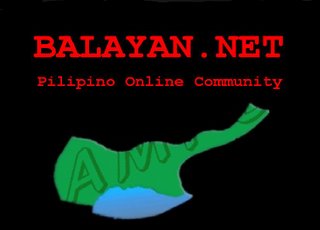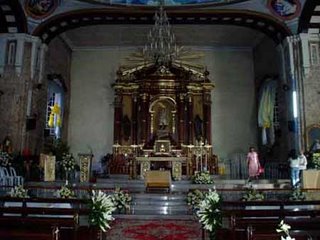The Balayaños Adventure
Monday, May 19, 2008
ALONE
From childhood's hour I have not been
As others were- I have not seen
As others saw- I could not bring
My passions from a common spring-
From the same source I have not taken
My sorrow- I could not awaken
My heart to joy at the same tone-
And all I lov'd- I lov'd alone-
Then- in my childhood- in the dawn
Of a most stormy life- was drawn
From ev'ry depth of good and ill
The mystery which binds me still-
From the torrent, or the fountain-
From the red cliff of the mountain-
From the sun that 'round me roll'd
In its autumn tint of gold-
From the lightning in the sky
As it passed me flying by-
From the thunder, and the storm-
And the cloud that took the form
(When all the rest of Heaven was blue)
Of a demon in my view.
A Special World
A special world for you and me
A special bond one cannot see
It wraps us up in its cocoon
And holds us fiercely in its womb.
Its fingers spread like fine spun gold
Gently nestling us to the fold
Like silken thread it holds us fast
Bonds like this are meant to last.
And though at times a thread may break
A new one forms in its wake
To bind us closer and keep us strong
In a special world, where we belong.
Thursday, February 01, 2007
Thursday, October 05, 2006
Thats LOve....
There is no difficulty that enough love will not conquer;
no disease that enough love will not heal;
no door that enough love will not open;
no gulf that enough love will not bridge;
no wall that enough love will not throw down;
no sin that enough love will not redeem...
It makes no difference how deeply seated may be the trouble;
how hopeless the outlook; how muddled the tangle; how great the mistake.
A sufficient realization of love will dissolve it all.
If only you could love enough you would be
the happiest and most powerful being in the world...
Monday, August 21, 2006
Monday, August 14, 2006
Thursday, July 13, 2006
Wednesday, July 12, 2006
Historic Beginnings of Balayan
The historic beginnings of Balayan date back to the early part of the 11th and 13th centuries during the years 1205 to 1258, which gives a comprehensive description of the Philippines, through the Chinese work of the South Seas of the Barbarians, down to the coming of the Chinese traders. Long before the arrival of the Spaniards, the place was already a big thriving village, a trading center of Chinese merchants and other traders of neighboring countries - first Malays, Mongoloids and Australians - who transport their goods for barter with the products of the natives. It is worth mentioning here, that: "According to WANG TAN YUAN, a Chinese writer in 1349, he praises the Filipino honesty in their commercial dealings. The natives and traders having agreed on prices that they let the former carry off the goods and the latter bring the amount of native products agreed upon. The traders trust them for they never fail to keep their bargains, even if it takes seven to eight months to return.
This place was first called "BON-BON" by the Muslim Natives, derived from the word "bongbong". A piece of bamboo being used by the natives to catch seafoods. It is located near and below the fabled majestic "BATULAW", a mountain of gold called "Batung Dilaw" which was belied to be the abode of the mythical fairy princess Dalisya, daughter of King Suay and Queen Tagaytay - which was inhabited by the early settlers called "Tayakads" and Sagubangs"
At a much later date, in the 13th century, according to tradition and as told in Maragtas, the place was invaded by the Visayan people under the leadership of Data Balensuela and Datu Dumagsil, two of the ten Datus who purchased Panay Island from the Negritos. These two datus founded first village at the south of Bonbon river - but Datu Balensuela settled in barrio Pooc, which was later on inherited by Datu Kumintang, the last of the descendants of the seven Datus who arrived in the Philippines from Borneo in 1472.
The legendary Datu was the least of the long line of local chieftains from the Stone Age community who yielded power over the vast regions. He resided in Balayan and ruled the place from 1570-1578. It was during this period that the town was named after him, KUMINTANG", meaning happy songs. It is significant to note here that two of the most important pre-Spanish Tagalog songs. Originated here - the "Kumintang" and the Kundiman" - love songs especially sang in serenading.
Datu Kumintang belonged to a royal blood of Malay from Borneo and that of a Tagalog (Kayumangging Kaligatan). He was a brave soldier, and gaining knowledge from experience, he trained many fighting men to fight invaders because immigrants and visiting traders from other parts of the world have been found to entertain the idea that this rich and thickly populated place would be their own.
In 1570, Martin de Goiti and Juan de Salcedo on their way to Manila crossed over to explore the coast of Batangas. Goiti anchored off the coast of what is now Balayan where the natives made peace and offered help to them. Salcedo on the other hand, entered the Bonbon River and sailed up toward the lake, to investigate the well-tilled and thickly inhabited region. Unfortunately, on the way the Spanish boats fell into the ambush, Salcedo was wounded in the thigh by a poisoned arrow, and decided to leave the hostile town. Years later, the rule of Datu Kumintang ended.
This region has been figured in most Chinese records as the center of the ancient country Mai-I from the word Bai, i.e. house. To a great majority of Filipino dialects including Visayan, Ilocano and others - the root world "Balay" means house hence Bai itself was replaced by the Visayan term Balayan and later the common Filipino affix, "an" was added, thus the name BALAYAN was coined. (And this term was never modified till today).
With the coming of Spaniards to Balay in 1572, the Franciscan missionaries led by Fr. Juan de Palencia, implanted Christianity here. The natives at once embraced the CROSS and did away with pagan worship that many were baptized. As the faith became deeply rooted, the need for a place of worship was felt, so in 1578 a church of light materials was urgently constructed which was believed to be in barrio Ermita today. - this being the shoreline then. This was under Fr. Francisco de Sta. Maria of the Franciscan order.
In 1578, the town of Balayan was officially recognized as a municipality under Spain by Fr. Estaban Ortiz and Fr. Juan de Porras, covering the towns now called Nasugbu, Lian, Calaca and Calatagan. It became the seat of first capital of the province known as Balayang or Kumintang, with jurisdiction extending over a vast territory including places presently known as Batangas, Mindoro, Marinduque and all lands on the southeastern part of Laguna as far as Camarines. It remained the capital from 1578-1778 for a period of 201 years. This province had already belonged to the Archdiocese of Manila and the people paid tribute from the encomiendas and private parties. The people had their own civilization and culture much advanced than those from other place at that time.
As time went by, the shoreline extended farther, that in 1572 the seat of the town proper had to be moved to the present site. In the same year the construction of the church with stone foundation started, along with the convent and the town hall (Presidencia). Stone walls where erected to hold back the water from the sea and these same walls are still found surrounding the present church patio.
Records show that in 1579 Archbishop Manuel Rojo blessed the newstone church and its grounds with great rejoicing of the faithful for having been visited by the Governor Generals as also the Head of the Church. His Excellency offered a solemn mass in honor of the Patron Saint of the town, Our Lady of the Immaculate Conception.
In 1749, the king of Spain sent individual letters to their petty kings or datus inviting them to come to terms to be converted to Catholicism. When the Marquis of Obando, the new Governor arrived in Manila and dispatched a squadron of soldiers to restore the king of Jolo and who later left for Zamboanga, the Muslim Natives suspected him of infidelity and for acts against Muslim religion that he was imprisoned, then sent back to Manila to accept any misfortune in store for him - until the time the British occupied the Philippines - and he was returned to his throne. The Mohammedans committed acts of hostilities not only in the Visayan provinces but also in regions near Manila. They entered the town of Balayan stayed in it for two months and before they departed, they burned the town.
In order to avoid a repetition of what had happened, the people of Balayan built a fort (KUTA) with the church and a convent inside it, so that in case of any invasion they could have security and a haven of refuge against the Moros of Jolo and Mindanao, who for the past 200 years have been harassing the archipelago, especially the coastal towns with their intermittent piratical attacks.
At the other end of Balayan, there is a small castle on top of a small hill (in what is now Talibayog) which commands a view of the seacoast, this castle called Talibahan is provided with cannons and a sentry, so that any strange craft entering the bay can be detected, and if any, to give warning signals - by building bonfires with high smoke and striking a big gong so the natives may be alerted but it did not work well that a strong fort replaced it. As soon as the fortresses of the neighboring towns: Bauan, Tall and Batangas were finished simultaneously the Moros ceased to come for hostile actions.
The province now called Batangas ha had several capitals. Northeast of Taal is the original capital Balayan - chosen in 1581 to administer the great district comprising all Southern Luzon including Bicol region, then called Balayan Province. In 1732, this great province has been so developed that it could not be properly governed from this town, so the province was cut down to its present size thus other provinces were created from the rest. In the same year, the seat of government was again necessitated the shifting of capital from Taal to Batangas and the whole province was called from that time on after its new capital then, Batangas province.
In 1833 the road to Batangas proper was opened and in 1849 the construction of the new cemetery started in barrio Ibabao, which is Barangay Ermita now. In 1855, the town was divided into barrios, each with a cabeza for every 100 houses.
The town of Balayan was twice under military occupations: first, under Gen. Bell of the American Expeditionary forces, and second, during the Japanese Military Occupation in 1941 when the Filipino soldiers fought side by side with the American Liberation forces against the Japanese Imperial Army somewhere in San Piro, Baha and Talibayog. It was in this last encounter where some unsung herores of the resistance lost their lives, i.e. Architect Lorenzo Galves, Dr. Rodolfo Bahi and amador Dequito and many others.
Balayan is one of the oldest towns of the western region of Batangas. It is bounded on the north by the municipality of Tuy, on the east by Calaca, on the south by Balayan bay and on the west by Lian and Calatagan. It is 107 km. To the south of Manila with a population of 55,000 people, with a total area of more than 20,000 Ha. Planted to sugar, coconut and corn and is famous or noted for a delicacy " Balayan Bagoong."
Today it is no longer the enconmienda of 600 men as it was 400 years ago but a rich thriving agricultural community who take pride in the history of its town that has reared men of distinction, to mention a few we have: Don Manuel Araullo - first chief Justice of the Supreme Court of the Philippines. Dr. Galicano Apacible member of the Revolutionary Junta, Provincial Governor of Bantangas, Member of the Philippine Assembly Secretary of Agriculture and Natural Resources First Ambassador to the United States. Don Sixto Lopez, the Grand Old Man of Balayan, a contemporary of General Malvar, who never recognized the American Sovereignty ( a hero by his own right) until his death.
WINNER
Are you a winner or a loser?
Winners are made, not born. Winning is the result of having a winner's mind and a winning, positive, “can do” attitude. Winning has everything to do with being at the right place at the right time as well as being ready to grab the opportunity and take the challenge to win. Winning takes determination and persistence. And as with most things in life, it takes practice to perfect. What differentiates a winner from a loser?
Here's how you can tell one from the other:
A winner makes it happen; a loser lets it happen.
A winner says, “I can do it!”, a loser says, “ I can't!”
A winner says, “I'm good, but I can be better!” ; a loser says, I'm better than the others!”
A winner says, “It will work!” a loser says, “It's impossible!”
A winner says, “I made a mistake”; a loser says, “It wasn't my fault!”
A winner says, “There has to be a better way to do it”; a loser says, “That's the way it has always been done before.”
A winner is persistent; a loser gives up easily.
A winner is decisive; a loser can't make up his mind.
A winner is not afraid to fail; a loser fears both failure and success.
A winner makes commitments, a loser makes promises.
A winner praises; a loser criticizes.
A winner tackles and solves the problem; a loser goes around and never gets it solved.
A winner explains; a loser complains.
A winner thinks big; a loser is narrow-minded.
A winner is optimistic; a loser is pessimistic.
A winner is confident; a loser is unsure.
A winner learns from his mistakes; a loser sulks over his mistakes.
A winner emulates successful people; a loser envies and badmouths them.
A winner encourages; a loser discourages.
A winner is motivated; a loser has low morale.
A winner listens to others; a loser thinks he alone is right.
A winner is interesting; a loser is bore.
A winner sweet-talks; a loser sour-grapes.
A winner looks before he leaps; a loser cries after leaping.
A winner is organized; a loser is confused.
A winner points out what went wrong; a loser blames.
A winner plans and manages time; a loser cannot find time.
A winner acts on it; a loser sits on it.
A winner learns from criticism; a loser is vindictive when criticized.
A winner cheers; a loser boos!
Broken Sonnet by Hale
And now I concede on the night
of this fifteenth song
Of melancholy, of melancholy
And now I will admit in this fourth line
That I love you, that i love you
I don't care what they say
I don't care what they do
Cause tonight I leave my fears behind
Cause tonight I'll be right at your side
The clock on the TV says 8:39 p.m.
It's the same, it's the same
And in this next line I'll say it all over again
That I love you, that i love you
I don't care what they say
I don't care what they do
Cause tonight I leave my fears behind
Cause tonight I'll be right at your side
Lie down right next to me
Lie down right next to me
And I will never let go, will never let go
I leave my fears behind
Cause tonight I'll be right at your side
Lie down right next to me
Lie down right next to me
And i will never let go, never let go
But still I see the tears from your eyes
Maybe I'm just not the one for you....






